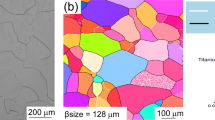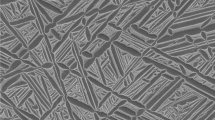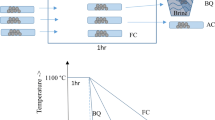Abstract
In this study, the effect of strain rate and temperature on the substructure evolution and mechanical response of a Ti3Al-Nb-Mo alloy (Ti-24.5Al-10.5Nb-l.5Mo) was investigated. The yield and flow stresses were found to decrease gradually with increasing temperature at the strain rate of 3000 s1 and no flow stress/temperature anomaly was observed. The variation of hardening behavior of Ti-24.5Al-10.5Nb-1.5Mo alloy with temperature and strain rate was found to be negligible, implying that the dynamic recovery mechanism for this alloy is rather athermal. Dynamic recovery of Ti-24.5Al-10.5Nb-l.5Mo alloy is thought to be quite difficult and slow because of its complicated dislocation core structure. Ti-24.5Al-10.5Nb-l.5Mo alloy exhibited predominantly planar dislocation debris after deformation. Following the room temperature deformation at low strain rate the majority of the dislocations were a-dislocations lying on the basal and 1storder pyramidal slip planes and the 2nd-order pyramidala/2+c slip on {1211}. Increasing the rate of deformation at room temperature to 6000 s1 resulted in the increaseda-slip on prism planes and the lessor amount of basal slip. At elevated temperatures, the substructure after high rate deformation was found to be similar to that following high rate deformation at room temperature except for an increased amount of basal slip and somewhat higher incidence of the 2nd-order pyramidal slip. The evidence of an increased amount of shearing of the βo phase was observed at elevated temperature, suggesting the decreased strength of the βo phase.
Similar content being viewed by others
References
H. A. Lipsitt, inHigh-Temperature Ordered Intermetallic Alloys, Vol. 39(eds.,.C. C. Koch, C. T. Liu, and N. S. Stoloff), p. 352, Materials Research Society, Pittsburgh, PA (1985).
R. G. Rowe, inHigh Temperature Aluminides and Intermetallics (eds., S. H. Whang, C. T. Liu, D. Pope, and J. Stiegler), p. 375, The Metallurgical Society, Warrendale, PA (1990).
J. M. Larsen, K. A. Williams, S. J. Balsone, and M. A. Stucke, —in, p. 521.
P. C. Gehlen, inThe Science, Technology, and Application of Titanium (eds., R. I. Jaffee and N. E. Promisel), p. 349, Pergamon Press, New York (1970).
S. M. L. Sastry and H. A. Lipsitt,Metall. Trans. 8A, 1543(1977).
H. A. Lipsitt, D. Schechtman. and R. E. Schafrik,Metall. Trans. 11A, 1369(1980).
S. M. L. Sastry and H. A. Lipsitt, inTitanium ’80 - Science and Technology (eds., H. Kimura and O. Izurni), p. 1231, The Metallurgical Society, Warrendale, PA (1980).
P. L. Martin, H. A. Lipsitt, N. T. Nuhfer, and J. C. Williams, —in, p. 1245.
D. A. Koss, D. Banerjee, D. A. Lukasak, and A. K. Go-gia, —in, p. 175.
S. A. Court, J. P. A. Lofvander, P. Kurath, and H. L. Frazer, inSixth World Conference on Titanium (eds., P. Lacombe, R. Tricot, and G. Beranger), p. 949, Les Editions de Physique, Paris, France (1989).
B. J. Marquardt, G. K. Scarr, J. C. Chesnutt. C. G. Rhodes, and H. L. Frazer, —in, p. 955.
Y-W. Kim and F. H. Froes, —in, p. 465.
A. K. Gogia, D. Banerjee, and T. K. Nandy,Metall. Trans. 21A, 609(1990).
D. Banerjee, A. K. Gogia, and T. K, Nandy,Metall. Trans. 21A, 627 (1990).
S. J. Gittis and D. A. Koss, inHigh-Temperature Ordered Intermetallic Alloys III, Vol. 133 (eds.,C. T. Liu, A. I. Taub, N. S. Stoloff, and C. C. Koch), p. 323, Materials Research Society, Pittsburgh, PA (1989).
D. A. Lukasak and D. A. Koss,Matall Trans. 21A, 135 (1990).
G. T. Gray III and P. S. Follansbee, —in, p. 117.
P. S. Follansbee and G. T. Gray III.Metall. Trans. 20A, 863 (1989).
L. S. Harbison, R. J. Bourcier, and D. A. Koss, inMicrostructure/Property Relationships in Titanium Alloys and Titanium Aluminides (eds., Y-W. Kim and R. R. Boyer), p. 437, The Metallurgical Society, Warrendale, PA (1991).
C. E. Frantz, P. S. Follansbee, and W. J. Wright, inHigh Energy Rate Fabrication (eds., I. Berman and J. W. Schroeder), p. 229, Am. Soc. Mech. Engr., NY (1984).
H. W. Sizek and G. T. Gray III,Acta Metall Mater. 41, 1855 (1993).
R. E. Schafrik,Metall. Trans. 8A, 1003 (1977).
Author information
Authors and Affiliations
Rights and permissions
About this article
Cite this article
Gray, G.T., Hong, S.I. & Marquardt, B.J. Effect of strain rate on the mechanical response of a Ti3Al-Nb-Mo alloy. Metals and Materials 2, 31–36 (1996). https://doi.org/10.1007/BF03025944
Issue Date:
DOI: https://doi.org/10.1007/BF03025944




